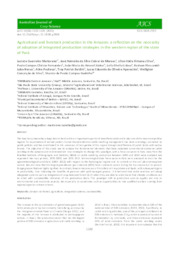Agricultural and livestock production in the Amazon: a reflection on the necessity of adoption of integrated production strategies in the western region of the state of Pará.
Agricultural and livestock production in the Amazon: a reflection on the necessity of adoption of integrated production strategies in the western region of the state of Pará.
Author(s): MARTORANO, L. G.; MORAES, J. R. da S. C. de; SILVA, L. K. X.; FERNANDES, P. C. C.; AMARAL JÚNIOR, J. M. do; LISBOA, L. S.; NEVES, K. A. L.; PACHECO, A.; BELDINI, T. P.; APARECIDO, L. E. de O.; SILVA, W. C. da; GODINHO, V. de P. C.
Summary: The Brazilian Amazon has a large bovine herd and is an important exporter of meat from cattle and is also one of the most competitive regions for exportation of animal protein. Conventional extensive cattle ranching management has been a strategy promoted by public policies and has contributed to the processes of occupation of the region through modification of public lands with native forests. The objective of this study was to analyze the fundamental elements that have sustained conventional extensive cattle ranching in the Amazon and to demonstrate new strategies to change this paradigm, with a focus on western Pará. Data from the Brazilian Institute of Geography and Statistics (IBGE) on cattle ranching production between 1990 and 2019 were analyzed and separated into two periods, 1990-2000, and 2001-2019. Meteorological data from western Pará were analyzed to describe the agrometeorological conditions (1989 -2012) with respect to the hydrological regime and its controls on the soil-plant-atmosphere system. Results show that the largest greenhouse gas emissions (GGE) from ruminants occurs during the dry season due to pasture forage grasses that are highly lignified. In contrast, lower emissions occur from diets rich in proteins and lipids, with subsequent gains in productivity, thus indicating the benefits of pastures with well-managed grasses. It is believed that cattle ranchers will adopt integrated systems such as integration of crop-livestock-forest (ICLF) when they are able to understand that climate conditions can be allied with sustainability indicators of the production chain. This paradigm shift in production systems applies not only to environmental and economic aspects, but especially to social ones such as opportunities to hire qualified workers coming from regional agrarian science schools
Publication year: 2021
Types of publication: Journal article
Unit: Embrapa Eastern Amazon
Observation
Some of Embrapa's publications are published as ePub files. To read them, use or download one of the following free software options to your computer or mobile device. Android: Google Play Books; IOS: iBooks; Windows and Linux: Calibre.
Access other publications
Access the Agricultural Research Database (BDPA) to consult Embrapa's full library collection and records.
Visit Embrapa Bookstore to purchase books and other publications sold by Embrapa.

